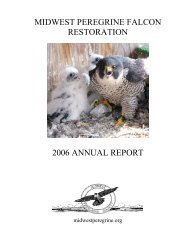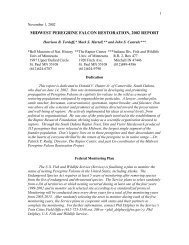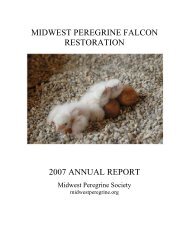1993 - Midwest Peregrine Falcon Restoration Project
1993 - Midwest Peregrine Falcon Restoration Project
1993 - Midwest Peregrine Falcon Restoration Project
Create successful ePaper yourself
Turn your PDF publications into a flip-book with our unique Google optimized e-Paper software.
young male was shot near Waterloo, Iowa, in September and is currently under<br />
care in The Raptor Center.<br />
7. Mayo Clinic, Rochester, Minnesota. Paul Scanlon, Mayo MD, reported two<br />
falcons at the Clinic on January 19. In March, female Minnsoar 75V, back for<br />
the third year, and male Chase 06T, fourth year, were identified by their black<br />
bands. They nested for the second time in a box on the Plummer Building, laying<br />
four eggs by April 9, according to Tom Hennessy, Mayo. Three hatched May 11 and<br />
12, and two males and one female fledged in mid-June. Hennessy and Ted Bartel,<br />
Mayo, reported that one male was killed on June 18 and the second on July 17 in<br />
collisions with glass-walled buildings.<br />
8. NSP Sherco Plant, Becker, Sherburne County, Minnesota. Back for the<br />
second year at this smokestack nest box were female 36R and male 94T, identified<br />
by Dan Orr, NSP biologist. In 1992, this pair failed to hatch their eggs but<br />
fledged two foster young. In <strong>1993</strong>, the first adult returned about March 22, the<br />
second by March 26. They produced four eggs, hatched four, and fledged all four<br />
young, three males and a female, in late June. Male 94T somehow lost his USFWS<br />
silver band between summer 1992 and spring <strong>1993</strong>. While paired with female 36R<br />
at the Sherco Plant, male 94T was also paired simultaneously with a<br />
female peregrine 31R at the NSP Monticello Plant, four miles to the south (see<br />
pair 44).<br />
9. Palisade Head, Lake County, Minnesota North Shore.<br />
An adult female peregrine arrived here on March 26; an adult male on March 29.<br />
Dudley Edmondson identified the female in early April as Fridge 43R, back for<br />
the sixth year. On May 21, Dave Evans and Tordoff identified the male as 71X,<br />
released on Isle Royale in 1991, nesting here for the first time. The pair used<br />
a new site at the extreme northeast end of the palisade, laid three eggs, and<br />
hatched one female chick which fledged in mid-July and was seen flying strongly<br />
by Edmondson in late July. We do not know the fate of the other eggs. Peter<br />
Smerud and Joe Walewski, Wolf Ridge Environmental Learning Center, did the<br />
climbing for banding the chick.<br />
10. Finnish Church cliff, 2 miles north of Tofte, Cook County, Minnesota.<br />
Wayne Russ found this pair and one flying juvenile on August 12, <strong>1993</strong>, when<br />
checking on local reports of peregrine activity. The site is about one mile<br />
from Mt. Leveaux where peregrines nested unsuccessfully in 1991 and 1992 but<br />
were absent in <strong>1993</strong>. On August 13, Tordoff identified the adult female as<br />
Algoma 77V, released in 1990 on Isle Royale MI. Russ thinks the adult male is<br />
unbanded. Although the juvenile was flying well, the defensive behavior of the<br />
adults indicated that they were still on their nesting territory, but the nest<br />
ledge was not located. The cliff is heavily wooded on top and falls sheer to<br />
the water but is only about 60 feet high. Several possible nest sites are<br />
screened by vegetation.<br />
11. Rouchleau Mine, Virginia, St. Louis County, Minnesota. Jerry McHugh<br />
and Jeff Lightfoot, MN DNR, report that peregrines were incubating in the old<br />
cliff hack box by mid-April. The adult female 25V was identified by distinctive<br />
plumage details as the same bird here in 1991 and 1992; the male all three years<br />
was very shy, probably the same individual but so difficult to see that we still<br />
do not know if he is banded. Four eggs were laid, all four hatched around May<br />
17, and two male and two female young were banded on June 8. While we were<br />
lowering the young to the nest after banding, a knot failed, dumping the box<br />
containing the chicks down the cliff. Only one male survived the fall; three<br />
additional young, two from Victor Hardaswick and one from Greg Moore, two males








